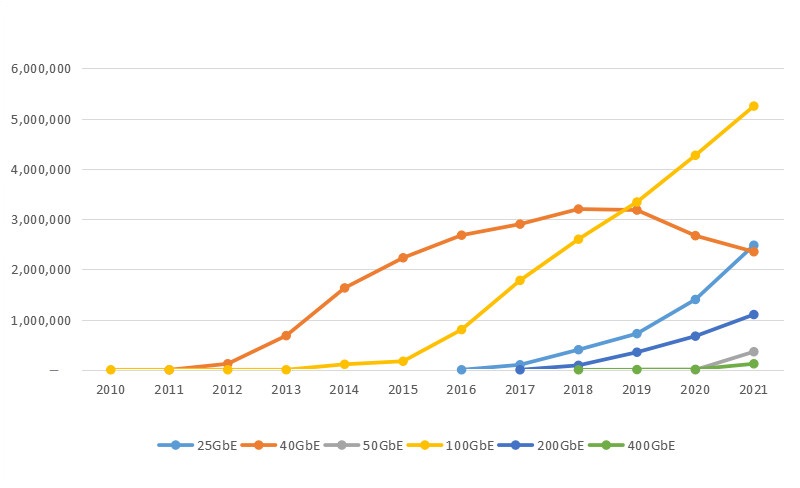
5G network drives the development of 25G optical module market
Date:2019-03-01Click:1155
The advent of the 5G era has driven the need for higher bandwidth and ultra-low latency networks, and a denser network structure is required to ensure coverage of 5G networks. Because the transmission rate of 5G prequel network is 25Gbps, so 25G optical module will be the main optical module in 5G pre-transmission network, then 25G optical module market in 5G pre-transmission network will develop? This paper will analyze the market of 25G optical modules in 5G prequel networks.
5G PREQUEL NETWORK PROMOTES THE DEVELOPMENT OF 25G OPTICAL MODULE MARKET
Considering the convenience and economy of network construction, the initial connection mode of 5G prequel network will be based on fiber optic direct connection scheme, passive WDM scheme as a supplement, and active WDM/OTN/SPN scheme as a supplement.

Figure 1: A diagram of the 5G prequel networking scheme
Fiber direct connection scheme is to each active antenna unit (AAU) and DU (distributed unit) all fiber point to point direct connection network, the implementation is simple, but will consume a large number of fiber resources, is the main way of pre-transmission network construction, generally using 25G gray light module, including 300m and 10km transmission distance.
In order to save fiber resources, 25G BiDi single fiber two-way optical module and 25G WDM optical module can be used. Using WDM technology, the 25G BiDi optical module reuses a variety of wavelengths on a fiber to support transmission distances of 300m and 10km. In passive WDM networking,25G WDM optical module can use WDM technology to connect multiple active antenna units (AAU) and DU (distributed units) to one fiber, while active WDM/OTN/SPN scheme requires OTN equipment between active antenna units (AAU) and DU (distributed units), and multiple signals can share fiber optics through WDM technology, which can not only save fiber resources, but also realize a variety of topology networking methods. Both of these networking methods are an effective complement to the fiber point-to-point direct networking method to solve the problem of insufficient optical fiber resources. Therefore, a large number of 25G optical modules will be used for 5G pre-transmission transmission, which has laid a solid foundation for the development of the 25G optical module market in the 5G prequel network.
25G LIGHT MODULE MARKET ANALYSIS AND FORECAST
MARKET DEVELOPMENT RATE DEMAND DRIVES THE DEVELOPMENT OF 25G OPTICAL MODULES
In 4G networks, the 10G SFP-plus optical module is the main optical module of the prequel network. However, compared with 4G networks, the total number of 5G Acer stations is expected to reach 1.3 to 1.5 times the number of 4G base stations, the number will exceed 5 million, which is driving the demand for higher-rate optical modules. With a transmission rate of 25Gbps for 5G prequel networks, the demand for 25G optical modules will soar, driving the 25G optical module market.
TECHNOLOGY IS DRIVING 25G
25G Ethernet technology is characterized by low cost, low power consumption and high density. With the increasing use of 25G optical modules in 5G networks, more and more optical module manufacturers will actively participate in the research and development of 25G optical modules around 5G applications, such as 25G BiDi and 25G WDM optical modules using WDM technology to save fiber resources in 5G pre-transmission network transmission.
COMPETITION IS DRIVING THE 25G OPTICAL MODULE MARKET
In addition, the fierce market competition will greatly promote the development of the 25G optical module market. By 2021, operators will be working to prepare network infrastructure and systems for the transition to 5G, and the market demand for 25G optical modules is expected to reach 2 million. In addition, 25G optical modules have laid the foundation for networks like higher-rate upgrades, such as 100G or 400G Ethernet, further stimulating the boom in the 25G optical module market. This means that the trial operation of 25G Ethernet and its full deployment by 2020 provide a bright future for the development of the 25G optical module market.

Figure 2: Market trends for 25G/40G/50G/100G/200G/400G optical modules
CONCLUSION
25G Ethernet as the starting point for 100G/400G networks, making the market for 25G optical modules more competitive and reaching new peaks in the next few years. Due to the increase in the number of 5G Acer stations, the improvement of 25G optical module solutions and the gradual reduction of costs, 25G optical modules will become the mainstream modules in the market in the near future.

